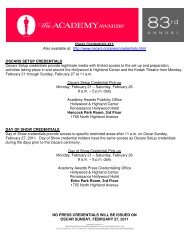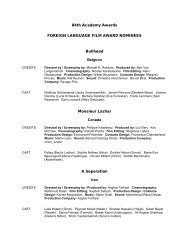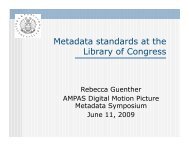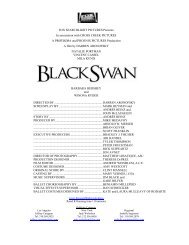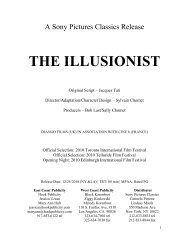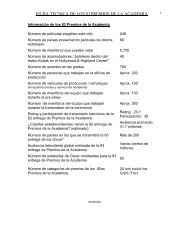Download Report - Academy of Motion Picture Arts and Sciences
Download Report - Academy of Motion Picture Arts and Sciences
Download Report - Academy of Motion Picture Arts and Sciences
You also want an ePaper? Increase the reach of your titles
YUMPU automatically turns print PDFs into web optimized ePapers that Google loves.
the plane perpendicular to the line <strong>of</strong> sight. The<br />
only way in which the observer can judge <strong>of</strong> the<br />
relative positions <strong>of</strong> the objects in the picture in<br />
respect to depth is by means <strong>of</strong> perspective. If the<br />
perspective be.faulty his interpretation <strong>of</strong> distances<br />
will be incorrect. Possibly the result will in no<br />
wise diminish his satisfaction with the picture; on<br />
the other h<strong>and</strong>, it might seriously impair the efiect<br />
the director <strong>and</strong> cameraman have striven to produce.<br />
This subject is discussed in a paper by A. C.<br />
Hardy <strong>and</strong> R. W. Conant, present last week at the<br />
meeting <strong>of</strong> the S. M. P. E. I am introducing the<br />
subject briefly in this paper for many <strong>of</strong> you who<br />
were not present at the time the paper referred to<br />
was read <strong>and</strong> in order to add one or two remarks.<br />
In monocular vision the most important indication<br />
<strong>of</strong> the relative distances from the eye <strong>of</strong> the<br />
various objects within the field <strong>of</strong> view is the apparent<br />
size <strong>of</strong> those objects. Our interpretation <strong>of</strong> distances<br />
from a consideration <strong>of</strong> apparent sizes is<br />
based on experience <strong>and</strong> involves an assumption that<br />
we know something <strong>of</strong> actual dimensions <strong>of</strong> the objects<br />
involved. If the actual dimensions <strong>of</strong> some <strong>of</strong><br />
the objects are unusual our judgment <strong>of</strong> distances<br />
will be incorrect. For example' suppose two automobiles<br />
were visible in an otherwise absolutely blank<br />
field so arranged that no part <strong>of</strong> the one obscured<br />
any part <strong>of</strong> the other. We would immediately locate<br />
them in space relative to each other on the basis <strong>of</strong><br />
their equality or inequality <strong>of</strong> apparent size, since<br />
we know from experience that regardless <strong>of</strong> difierences<br />
in wheel base, the width <strong>and</strong> height <strong>of</strong> automobiles<br />
does not difier greatly between different<br />
models. If. however, one <strong>of</strong> the cars was replaced<br />
by a perfectly proportional miniature our judgment<br />
would be violently upset. The difierence in apparent<br />
size <strong>of</strong>.the two cars will depend on the distance<br />
o{ the observer from the nearer car as well as upon<br />
their separation, the difierence between them diminishing<br />
as his distance from them increases, so that<br />
his judgment as to the separation <strong>of</strong> the cars one<br />
from another depends upon some prior judgment as<br />
to his distance from one or the other <strong>of</strong> them. This<br />
judgment can be formed even in otherwise vacant<br />
field <strong>of</strong> view on the basis <strong>of</strong> the apparent size <strong>of</strong> that<br />
car compared to the extent <strong>of</strong> his whole field <strong>of</strong><br />
view. If this were the first time he had seen an<br />
automobile he would be utterly unable to form any<br />
opinion <strong>of</strong> its distance because he would have no<br />
idea <strong>of</strong> its dimensions. If the unknown automobile<br />
appeared in a field containing familiar objects he<br />
would at once be able to form an estimate <strong>of</strong> its<br />
distance <strong>and</strong> <strong>of</strong> its dimensions.<br />
<strong>Motion</strong> picture sets usually contain familiar objects.<br />
The observer viewing the picture on the<br />
screen estimates his distance from the scene {rom the<br />
appearance <strong>of</strong> the dominating object within the field<br />
<strong>and</strong> locates the other objects within the field on this<br />
basis, combined with a consideration <strong>of</strong> their apparent<br />
relative sizes,<br />
Perspective is a matter <strong>of</strong> relative apparent sizes.<br />
The expressions, true or faulty perspective, are<br />
t s4l<br />
meaningless unless they assume a definite point <strong>of</strong><br />
view for the observer. Assuming the lens is free<br />
from distortion, the perspective <strong>of</strong> a negative will<br />
always be true if viewed from a distance equal to<br />
the distance from the second nodal point <strong>of</strong> the lens<br />
to the plate or film when the exposure was made'<br />
VieweJ from any other distance, the perspective <strong>of</strong><br />
the negative will be faulty. It cannot be said,<br />
there{oie, that perspective depends upon the focal<br />
length <strong>of</strong> the lens without qualification in the {orm<br />
o{ a specification <strong>of</strong> the viewing distance. Similarly<br />
the perspective <strong>of</strong> the projected picture will be true<br />
or false,- according to the relation between the focal<br />
length <strong>of</strong> the lens used for projection <strong>and</strong> the viewing<br />
distance <strong>of</strong> the observer. If the observer st<strong>and</strong>s<br />
atlhe projection machine' true perspective dem<strong>and</strong>s<br />
that piojettion be accomplished with a lens whose<br />
focal length is the same as that <strong>of</strong> the taking lens'<br />
In motion picture practice this is very rarely done,<br />
<strong>and</strong> as a consequence the perspective <strong>of</strong> the projected<br />
picture viewed from the projection booth is always<br />
false. This is usually but not always apparent. For<br />
any other distance from the screen the focal length<br />
<strong>of</strong> the projection lens necessary to give true perspective<br />
can be computed by multiplying the total projection<br />
distance by the focal length <strong>of</strong> the camera<br />
lens <strong>and</strong> dividing by the distance from the observer<br />
to the screen. This relation was brought out by<br />
Hardy <strong>and</strong> Conant, who also point out that for the<br />
usual 2-inch lens used in cinematography the projection<br />
lens should have a focal length <strong>of</strong> 4 inches<br />
in order that correct perspective be maintained for<br />
an observer seated half way from screen to projector,<br />
leading therefore to best average perspective for<br />
the entire house. The general use <strong>of</strong> a 4-inch projection<br />
lens would lead to larger screens than are<br />
common. Probably the average projection lens is<br />
nearer 6 inches in the larger <strong>and</strong> better theatres, so<br />
that better average perspective in the projected picture<br />
would follow the use <strong>of</strong> a focal length <strong>of</strong> 3<br />
inches in the camera.<br />
Probably the usual result <strong>of</strong> false perspective in<br />
the projected picture is a slight deterioration <strong>of</strong> composition<br />
without the observer realizing that anything<br />
is wrong, but in the case <strong>of</strong> any well-known object<br />
filling a good share <strong>of</strong> the field <strong>of</strong> view some very<br />
unpleasing results follow. To illustrate this I am<br />
using some slides, prepared by Hardy <strong>and</strong> Conant<br />
<strong>and</strong> used to illustrate their paper, which demonstrate<br />
how unsatisfactory results can be.<br />
In order to prevent any misunderst<strong>and</strong>ing it remains<br />
to be pointed out that this f alse perspective <strong>of</strong><br />
which I have been speaking is not related to the distorted<br />
perspective one sees when he views the picture<br />
on the screen from a seat at the side <strong>of</strong> the theatre.<br />
One's perception <strong>of</strong> depth is unaffected by his lateral<br />
displacement with reference to the line <strong>of</strong> projection,<br />
but one does find the apparent width o{ all<br />
objects in the picture to be afiected thereby while<br />
their heights remain constant. In so {ar as the observer's<br />
perception <strong>of</strong> depth is concerned only his<br />
l<br />
j




